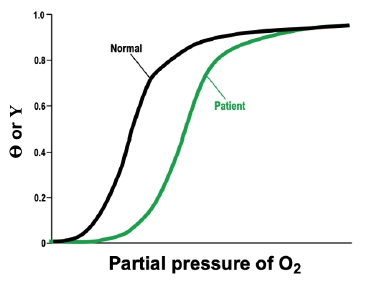In this video, we're going to begin our discussion on BPG regulation of hemoglobin. So BPG is a molecule that actually does affect hemoglobin's oxygen binding activity. And so BPG is really just an abbreviation for the molecule 2,3-bisphosphoglycerate. And the "bi" here is a prefix that means 2, and the "phospho" is referring to phosphate groups. So BPG has 2 phosphate groups, just like what we can see down below in this image. We have a phosphate group over here and another phosphate group over here. And so this is referring to BPG's structure, which I don't expect you guys to be able to memorize. However, I want you to know that the naming has to do with the structure of the molecule.
Now, what I also want you guys to realize is that sometimes this prefix "bi" is replaced with "di", which also means 2. And so sometimes BPG is abbreviated as DPG instead. However, both DPG and BPG are referring to the same exact molecule down below. The only difference is just a little difference here, in this prefix "di" versus "bi". Now, moving forward in our course, I'm mainly going to be referring to this molecule as BPG because I found that it's more commonly referred to as BPG.
BPG, as we'll see moving forward, is really going to act as an allosteric inhibitor reducing hemoglobin's oxygen affinity in the tissues and allowing hemoglobin to release even more oxygen to the tissues when appropriate. And so what this means is that this molecule BPG is really going to have a very similar effect to carbon dioxide and protons on hemoglobin's oxygen binding activity. And so BPG is going to act just like a negative heterotrophic allosteric inhibitor of hemoglobin oxygen binding. And again, "hetero" is just referring to the fact that BPG is a different molecule than oxygen. The negative is referring to the fact that this is acting as an inhibitor to decrease hemoglobin's oxygen binding. And of course, recall from our previous lesson videos that negative heterotrophic allosteric inhibitors are going to cause the shift, the curve to shift towards the right. Just like carbon dioxide and protons did, for hemoglobin's activity. So again, you can really think of the effect of BPG as being very similar to the effect of carbon dioxide and protons.
Now, this molecule, BPG, is actually present within all of our erythrocytes, which again are our red blood cells. However, as we'll see moving forward, BPG is only going to affect hemoglobin when it's in the tissues. And part of the reason for that is because the binding site to hemoglobin, BPG's binding site to hemoglobin, it is only available when hemoglobin is in the t state. And so recall that the t state is the tense state that binds oxygen inefficiently. And so again, BPG, just like carbon dioxide and protons, is going to be stabilizing the t state further, because it binds to the t state. Now, because that's true, BPG is actually going to be always binding to deoxygenated hemoglobin. And of course, BPG is not going to be binding to hemoglobin covalently because that would indicate some kind of permanent or long-term interaction. Instead, BPG interacts with deoxygenated hemoglobin via electrostatic noncovalent interactions. Again stabilizing hemoglobin's t state as we already mentioned.
And so if we take a look at our image down below over here on the left-hand side, what you'll notice is we have a little equation to help you guys understand BPG's effect. And so, notice over here what we have is oxygenated hemoglobin. And in the presence of BPG, BPG can actually cause hemoglobin to release its oxygen. And so, really, this is the expression that we can think about, that shows how BPG can lead to more oxygen being released. Because, again, when BPG is present, it will bind to hemoglobin and cause it to release its oxygen.
Now over here, what we have is an oxygen saturation curve where we have \( \theta \) or \( y \), or the fractional saturation on the y-axis, and then we have the partial pressure of oxygen in units of torrs on the x-axis and we've got these 3 different curves here. We've got this black curve right here that represents hemoglobin's curve when there is absolutely no BPG that's present. And notice that it does have a slight sigmoidal curve, but it's not nearly as sigmoidal as these other two curves that we see over here. So, this next curve that we see here is basically hemoglobin with some BPG, not a lot, but some BPG. And notice that the curve is being shifted to the right, when we add BPG. With respect to the black curve right here. This curve that has some BPG is being shifted to the right. And then this last curve that we see here, this orangest one is hemoglobin with even more BPG. So, what you'll notice is that when we add even more BPG, hemoglobin's curve begins to take even more of a sigmoidal shape. And, really, we can see that BPG is acting as a negative heterotrophic allosteric effector because of this shift to the right that we see with these curves.
And so in our next video, we'll be able to talk more about how BPG only affects hemoglobin's oxygen activity when it's in the tissues and not in the lungs. So I'll see you guys in that video.


